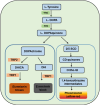The Pomegranate Flower Water Extract Negatively Regulates Melanogenesis by Suppressing MITF Expression and Its Target Enzymes
- PMID: 40232012
- PMCID: PMC11998895
- DOI: 10.1111/jocd.70163
The Pomegranate Flower Water Extract Negatively Regulates Melanogenesis by Suppressing MITF Expression and Its Target Enzymes
Abstract
Background: The aesthetic issues caused by pigmentation are increasing people's demand for skin whitening. Considering its long-term use, it is very important for searching safe and effective agents. Pomegranate flower, a kind of traditional Chinese medicine, has shown promising anti-inflammatory, antioxidant, and antidiabetic properties, but its potential skin-lightening effects have not been well explored.
Aims: We investigated the effect of pomegranate flower water extract (PFE) on skin lightening and elucidated its underlying mechanisms.
Methods: The radical scavenging capacity was measured by ABTS and DPPH assays, and the mechanism of lightening was detected by Western blot.
Results: PFE could obviously inhibit tyrosinase activity, which its inhibition IC50 value was lower than the positive control, kojic acid. Meanwhile, the radical scavenging capacity was also better than vitamin C (VC). Then the synthesis ability of melanin was measured in B16F10 cells; we found that PFE, in its safe concentrations, could reduce the synthesis of melanin resulting from inhibiting TYR activities. The expression of the main melanogenesis enzymes TYR, TRP-1, and TRP-2 was sharply reduced. Interestingly, MITF, a transcription factor of TYR, was obviously decreased its expression when treated with PFE at 50, 100, and 150 μg/mL, which was even significantly lower than the downregulation by kojic acid.
Conclusion: Pomegranate flower extract possessed a strong antimelanogenesis effect, which resulted from inhibiting the expression of MITF and its downstream target enzymes involved in melanin synthesis. These findings provide a strong scientific basis for the use of PFE as a safe and effective skin-lightening ingredient in the cosmetic industry.
Keywords: antimelanogenesis; cosmetic; melanin; pomegranate flower water extract; tyrosinase activity.
© 2025 The Author(s). Journal of Cosmetic Dermatology published by Wiley Periodicals LLC.
Conflict of interest statement
The authors declare no conflicts of interest.
Figures






Similar articles
-
Isoorientin derived from Gentiana veitchiorum Hemsl. flowers inhibits melanogenesis by down-regulating MITF-induced tyrosinase expression.Phytomedicine. 2019 Apr;57:129-136. doi: 10.1016/j.phymed.2018.12.006. Epub 2018 Dec 10. Phytomedicine. 2019. PMID: 30668315
-
Glycyrrhiza glabra extract as a skin-whitening Agent: Identification of active components and CRTC1/MITF pathway-inhibition mechanism.J Ethnopharmacol. 2025 Jun 12;349:119948. doi: 10.1016/j.jep.2025.119948. Epub 2025 May 9. J Ethnopharmacol. 2025. PMID: 40350048
-
Inhibitory effects of adlay extract on melanin production and cellular oxygen stress in B16F10 melanoma cells.Int J Mol Sci. 2014 Sep 19;15(9):16665-79. doi: 10.3390/ijms150916665. Int J Mol Sci. 2014. PMID: 25244016 Free PMC article.
-
Peptide Design for Enhanced Anti-Melanogenesis: Optimizing Molecular Weight, Polarity, and Cyclization.Drug Des Devel Ther. 2025 Jan 27;19:645-670. doi: 10.2147/DDDT.S500004. eCollection 2025. Drug Des Devel Ther. 2025. PMID: 39896936 Free PMC article. Review.
-
Molecular understanding of the therapeutic potential of melanin inhibiting natural products.RSC Med Chem. 2024 May 10;15(7):2226-2253. doi: 10.1039/d4md00224e. eCollection 2024 Jul 17. RSC Med Chem. 2024. PMID: 39026645 Free PMC article. Review.
References
-
- Cox C. and Khosrotehrani K., “Pigment Disorders,” Australasian Journal of Dermatology 63 (2022): 123–126, 10.1111/ajd.15_13832. - DOI
MeSH terms
Substances
Grants and funding
LinkOut - more resources
Full Text Sources

